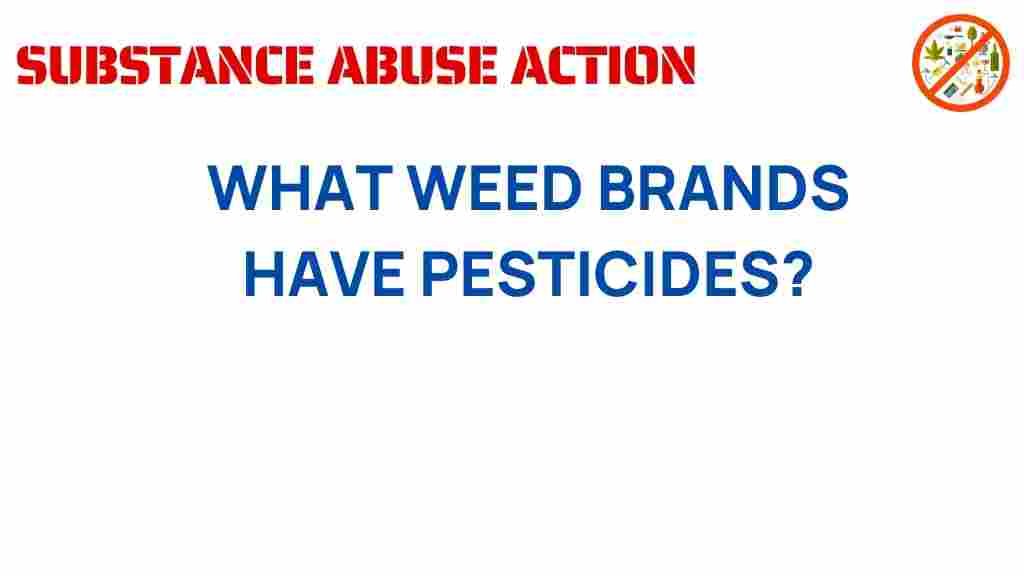Unveiling the Truth: Which Weed Brands May Contain Pesticides?
As the cannabis market continues to expand, consumer awareness regarding cannabis safety has become increasingly important. With a rise in popularity, many consumers are left wondering about the quality of the products they are purchasing. One significant concern is the presence of pesticides in various weed brands. In this article, we will explore the health risks associated with pesticide contamination, the importance of product testing, and how regulations shape the cannabis industry.
The Importance of Cannabis Safety
When it comes to cannabis consumption, ensuring safety is paramount. Many consumers may not realize that cannabis plants can be treated with various chemicals to control pests and diseases. While this practice might seem beneficial for crop yields, it raises serious health concerns. Here are some key points to consider:
- Health Risks: Exposure to harmful pesticides can lead to a range of health issues, from mild allergic reactions to severe long-term effects, including respiratory problems and cancer.
- Organic Cannabis: Choosing organic cannabis can mitigate the risk of pesticide exposure, as these products are grown without synthetic chemicals.
- Consumer Awareness: It is essential for consumers to be informed about the products they are purchasing and the potential risks involved.
How Pesticides Affect Cannabis Quality
Pesticides can not only pose health risks but can also affect the quality of cannabis. Contaminated products might have altered flavors, aromas, and even potency. Understanding how these chemicals impact cannabis can help consumers make better choices:
- Flavor and Aroma: Pesticides can leave a residual taste that detracts from the natural flavors and aromas of the cannabis flower.
- Potency: Some studies suggest that pesticide-treated cannabis may have reduced cannabinoid levels, affecting the overall experience.
- Safety Standards: Many states have implemented regulations to ensure that cannabis products are tested for pesticide residues, but compliance varies widely.
Step-by-Step Process for Ensuring Safe Cannabis Consumption
To minimize the risks associated with pesticides in cannabis, consumers can follow a systematic approach when selecting products:
1. Research Weed Brands
Begin by identifying reputable weed brands known for their commitment to safety and quality. Look for brands that prioritize transparency in their sourcing and production processes.
2. Check for Product Testing
Always inquire about or check for third-party lab testing results. These tests should confirm the absence of harmful pesticides and other contaminants. Trustworthy brands will readily provide this information.
3. Look for Organic Certifications
If possible, choose cannabis products that are certified organic. These products typically have stricter standards and are less likely to contain harmful pesticides.
4. Read Customer Reviews
Consumer feedback can offer valuable insights into the quality and safety of a brand’s products. Look for reviews that mention safety, product quality, and any concerns regarding pesticides.
5. Stay Informed About Regulations
Keep yourself updated on local cannabis regulations. Governments are continually updating their policies regarding cannabis safety and pesticide use, and being informed can help you make safer choices.
Common Pesticides Found in Cannabis Products
Understanding which pesticides are commonly found in cannabis can further enhance consumer awareness. Here are some frequently encountered pesticides:
- Pyrethroids: Commonly used for insect control, these synthetic chemicals can be harmful to humans and the environment.
- Imidacloprid: A neonicotinoid pesticide that has been linked to potential neurotoxic effects.
- Chlorpyrifos: Known for its adverse health effects, this pesticide is banned in several states but may still be found in unregulated markets.
Health Risks Associated with Pesticide Exposure
Exposure to pesticides can lead to various health issues, which may include:
- Respiratory Problems: Many pesticides can irritate the lungs and lead to chronic respiratory diseases.
- Cancer Risks: Some pesticides are classified as carcinogenic and can increase the risk of developing cancer with prolonged exposure.
- Neurological Effects: Certain pesticides can adversely affect the nervous system, leading to developmental issues or neurological disorders.
Regulations and Industry Standards
The cannabis industry is subject to varying regulations depending on the state. These regulations can dictate how cannabis is grown, processed, and tested. Here’s an overview:
- State Regulations: Many states require cannabis products to undergo rigorous testing for pesticides and other contaminants before reaching consumers.
- Industry Standards: Organizations such as the Cannabis Safety Institute work to establish and promote best practices for cannabis testing and safety.
- Consumer Protection: Regulatory bodies aim to protect consumers by ensuring that cannabis products meet specific safety standards.
Troubleshooting Tips for Concerned Consumers
If you suspect that your cannabis product may contain harmful pesticides, consider the following troubleshooting tips:
1. Identify Symptoms
Be aware of any adverse health symptoms after consuming cannabis. Common signs of pesticide exposure may include:
- Allergic reactions such as rashes or itching
- Respiratory issues like coughing or shortness of breath
- Gastrointestinal distress
2. Consult with Healthcare Professionals
If you experience any concerning symptoms, it’s crucial to consult with a healthcare professional. They can provide guidance and may recommend specific tests.
3. Report Unsafe Products
If you believe you have purchased a contaminated product, report it to your local health department or regulatory body. This helps protect other consumers and may lead to further investigations.
Conclusion
In conclusion, consumer awareness regarding pesticides in cannabis products is essential for ensuring cannabis safety and protecting health. By researching weed brands, checking for product testing, and staying informed about regulations, consumers can minimize their risk of exposure to harmful chemicals. Always prioritize products that adhere to stringent safety standards and consider organic options when available. For more information on cannabis safety and regulations, you can visit this resource.
By taking proactive steps, consumers can enjoy cannabis responsibly while safeguarding their health and well-being.
This article is in the category Health and created by SubstanceAbuseAction Team
